The Caryatids of Athens and the Enchanted of Thessaloniki

The caryatids, Erechtheion, Acropolis, Athens.
Caryatids are draped, sculpted female figures, supportive Goddesses so to speak, used as decorative support in place of columns or pillars, called in Greek Karyatides.
The most famous caryatids of Greece stand guard over the Erechtheion of the Acropolis, Athens.

The caryatids, Erechtheion, Acropolis, Athens
The origins of the Caryatids
In the ancient town of Karyes, Laconia, in the Peloponnese, was the sanctuary of Artemis Caryatis, (Artemis of the walnut tree).
The young girls, the maidens of Karyes; the Karyatides, watched over and cared for the sanctuary where, each year, on the celebration of Artemis, the young girls visited the sanctuary, carrying upon their heads, heavy amounts of fruit and walnuts as offerings and this is how the name caryatid is thought to have come about.

Karyes, Laconia, in the Peloponnese
Another story with thoughts on how the caryatids came about, not much loved by the Greeks I must add, was told by Vitruvius, a Roman author, architect, civil engineer and military engineer during the 1st century BC.
According to Vitruvius, during the War between Greece and Persia, the citizens of Karyes took sides with the Persians and lost.
As revenge for their treachery, Greece declared war on Karyes, killing the male population and taking the women into slavery.
To remember this occasion the women of Karyes were forever after depicted as women suffering under a burden.

Caryatids Erechtheion Acropolis Athens
Photo by mjharrington
Originally, for over two and a half thousand years, six of these beauties, carved from Pentelic marble, mined from the slopes of Mount Pentelicus and standing two and a half meters tall, watched over the south porch of the Erechtheion on the north side of the Acropolis, Athens.

The intricate hairstyles of the Caryatids
Sadly, while plundering the Acropolis from 1801 to 1805, Lord Elgin removed one of these sacred sisters and she now stands alone in the British museum London, with the rest of the looted Parthenon Marbles.
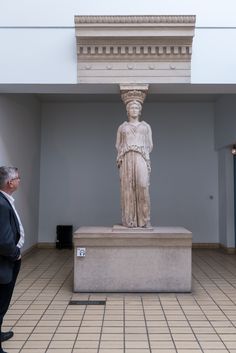
Caryatis taken by Lord Elgin now in British museum
The Erechtheion, an ancient Greek temple created by the sculptor Phidias (420 – 406 BC), was dedicated to the Goddess Athena and Poseidon; the two Greek gods who took part in the contest to determine whose name the city of Athens, previously named Cecrops, would take.
Obviously Athena won!

Erechtheion, Acropolis, Athens
On the south side of the Erechtheion is The Porch of the Caryatids, or, The Porch of the Maidens, where the most sacred relic of Athens was housed, the Palladium, a olive wood effigy of the Goddess Pallas Athena, said not to have been made by human hand, but to have miraculously fallen from heaven.

A caryatid looking out at the Parthenon from the Erechtheion of the Acropolis, Athens, Greece
In 1978 the five caryatids were removed from the Erechtheion, and replaced with replicas, to save them from the pollution of Athens, and taken to the Acropolis Museum, where they remained on permanent display until they were taken to the New Acropolis Museum which opened in 2009.
The five caryatids are displayed, with a place ready and waiting for their sixth sister, should she return home from London.
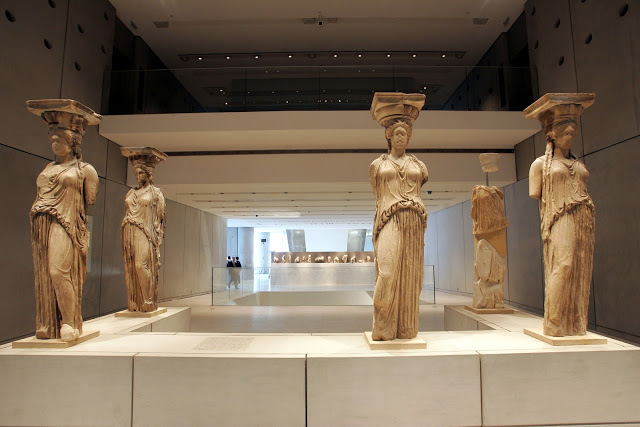
Caryatids New Acropolis Museum Athens
The male equivalent of the caryatids, which came into use many years after their female counterparts, are known as Atlas or Atlantes, after the Titan God Atlas, who was forced to carry the weight of the world on his shoulders for all eternity.
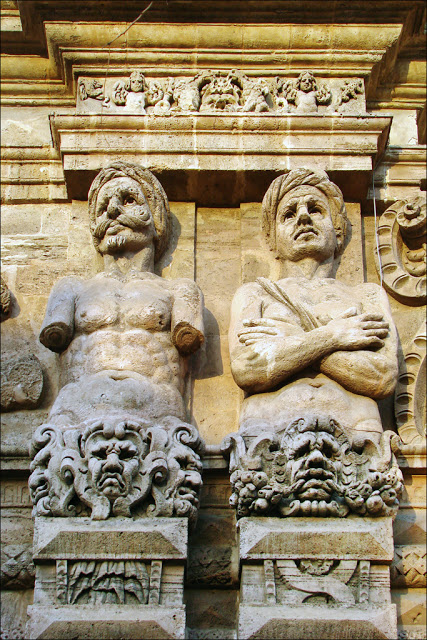
Atlantes, male equivelent of caryatids, depicting the Moors defeated by Charles V,Porta Nuova, Palermo. PhotoJean-Pierre Dalbéra
The Henri Cartier – Bresson Caryatids
Two more caryatids are well known in Athens, well, maybe only by the Greeks.
A small, rather nondescript house at 45 Agion Asomaton Street, became quite an Athenian landmark after it caught the eye of famous French photographer Henri Cartier-Bresson.
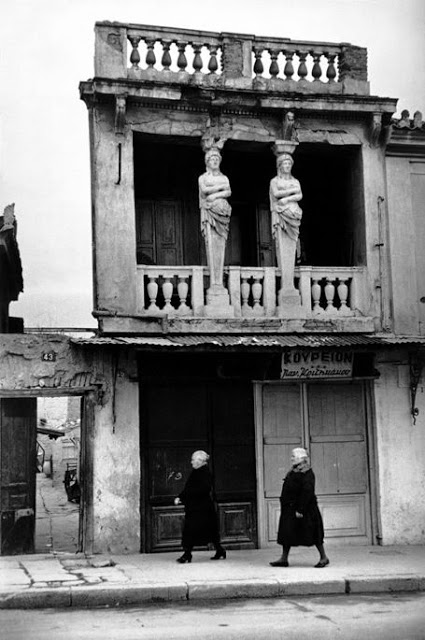
The house with the caryatids – 45 Agion Asomaton Street Athens 1953 – By Henri Cartier-Bresson

The house with the caryatids. 45 Agion Asomaton Street Athens 1978
Henri Cartier-Bresson’s iconic photograph of ‘The House with the Caryatids’ set the pace and the small house, it’s balcony decorated with a couple of caryatids, has now been photographed many times over.
Yiannis Tsarouchis, a famous Greek artist, loved it so much; he painted a picture of it!
 by Yiannis Tsarouchis - Copy - Copy.jpg)
House with Caryatids (1952), by Yiannis Tsarouchis
Las Incantadas – The Enchanted – The Magemenes:
The Caryatids of Thessaloniki
Until I read, (twice actually it was so good), ‘Salonica, City of Ghosts: Christians, Muslims and Jews 1430 – 1950’ by Mark Mazower, an ‘unputdownable’ book, I knew nothing of the sad story of Las Incantadas; the enchanted or magical Caryatids of Thessaloniki; Greece’s second largest city, up in the north.

Salonica, City of Ghosts Christians, Muslims and Jews 1430 – 1950 by Mark Mazower.
I’m not sure many Greeks knew about Las Incantadas either, as everyone I asked had never heard of them, maybe that has changed now, as in 2017 replicas were brought to the Archaeological Museum of Thessaloniki.
Many, many years ago, there stood, in Rogas, (The Jewish Quarter of Thessaloniki), in the courtyard of Liaci Arditi; a wealthy Jewish cloth merchant, the remains of an ancient Roman Forum, from the time of the occupation of Greece by the Roman Empire.

Las Incantadas-The Enchanted Thessaloniki. Engraving by James Athenian Stiuart, 1762.
Decorating the south entrance of this ancient Roman Forum, as part of a Corinthian Colonnade, stood four double – sided, two – faced caryatids, dating back to the second century AD.
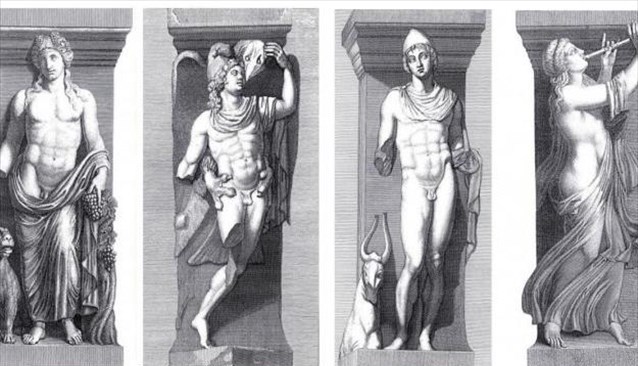
The Enchanted – The Thessaloniki caryatids – From left to right – Dionysus Ganymedes Dioscouros Mainad
These caryatids depicted on one side Dionysus, Ganymede, a Dioscouros (one of a set of twins in mythology) and Mainad, on the other was Ariadne, Aura, Lida and Niki.
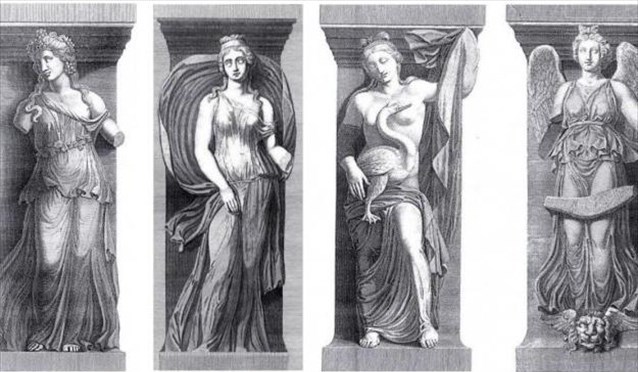
The Enchanted – The Thessaloniki caryatids – From left to right Ariadne Aura Lida Niki
The caryatids were known, in Ladino, (the Judeo Spanish language of Sepherdic Jews), as Las Incantadas and by the Christians as The Enchanted and in Greek, The Magemenes, meaning the magical.
The place in which they were situated was known as ‘The Arcade of the Idols’ by Christians and ‘Suret Maleh’ (the angel figures) by the Ottomans.
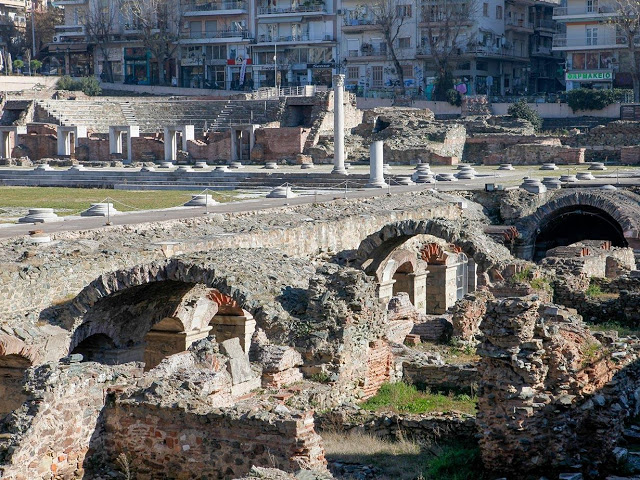
Remains of Roman Forum – Thessaloniki
Today this is the area just above Egnatia Street, to Filippou Street and from Agiou Nikolaou to Venizelou Street, in Thessaloniki.
In 1864 a French historian, Emmanuel Miller, visited Thessaloniki and with a permit from the Ottoman government (Greece was under Ottoman rule at the time, which lasted from 1453 until 1821) and orders from Napoleon III, removed Las Incantadas; the four caryatids, put them aboard the ship ‘La Muette’ and sent them to France.
Since then, the Enchanted, or, Las Incantadas, have been housed in the Louvre Museum, Paris.
Shades of Elgin and the Parthenon Marbles!
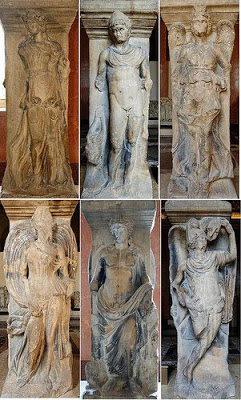
Las Incatadas The Enchanted Thessaloniki caryatids Louvre Paris
Until 1864 the four caryatids; the Las Incantadas, were the symbol of the city of Thessaloniki, only after their removal by the French, did the White Tower become the symbol of Thessaloniki.

Thessaloniki’s White Tower | © emiliamaghiar / Pixabay
The cloth merchant’s house was destroyed in the terrible fire of Thessaloniki in 1917.
After many years of negotiations between Greece and France, four resin replicas were made of the Las Incantadas caryatids by the French and shipped to Greece (a miserable substitute).

2015 Greece’s Enchanted Caryatids, return – as copies – to their Birthplace, Thessaloniki
Since 2017 the Las Incantadas stand guard at the entrance of the Archeological Museum of Thessaloniki.
Random Caryatids
It seems caryatids were rather popular, many versions can be seen around the world, what is it though, that makes them look so much more beautiful in Greece?
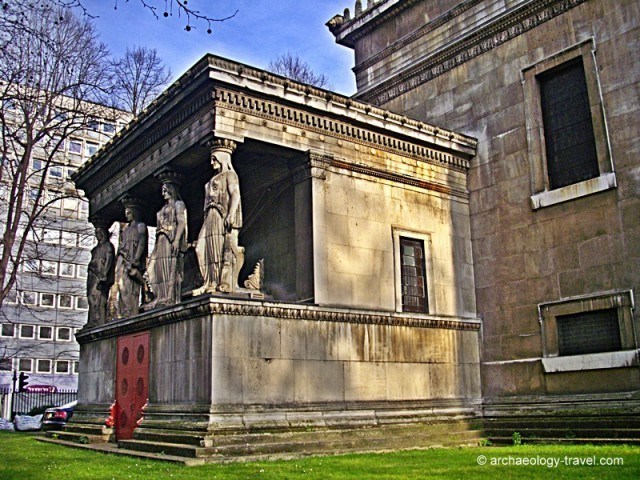
Caryatids at Saint Pancas New Church London. Photo Thomas Dowson

Field Museum chicago. Photo Thomas Dowson
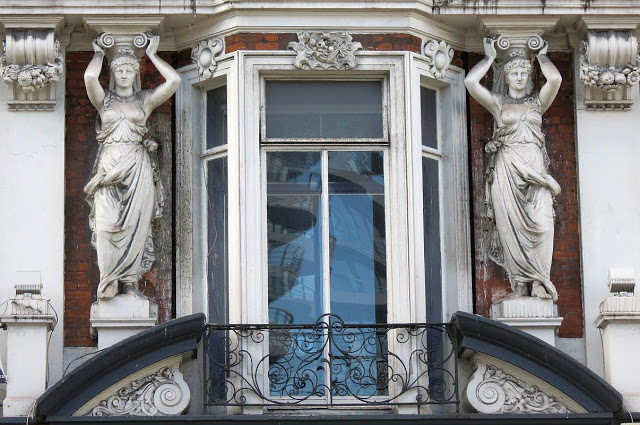
P&O Line Building in Cockspur Street, by Trafalgar Square, London
If you enjoyed this post, you may like the following:
How the Aegean Sea got its Name
Why is Greece called Hellas and who are the Hellenes?



